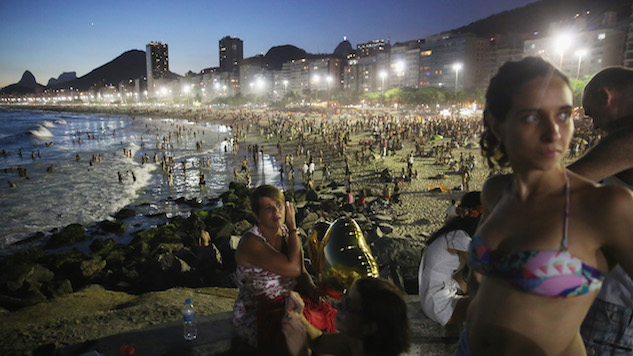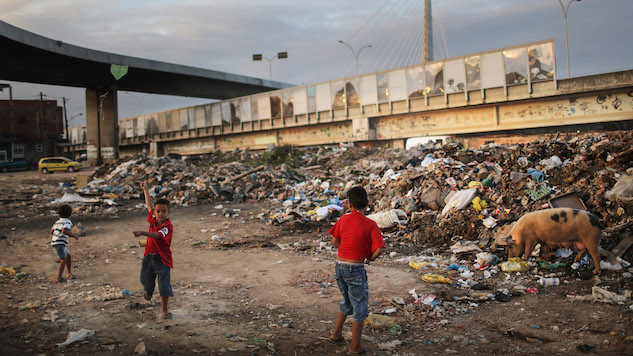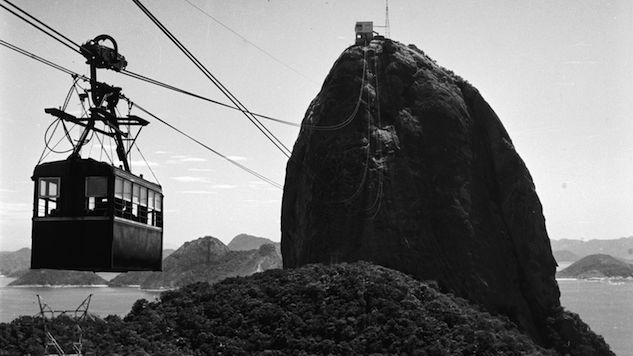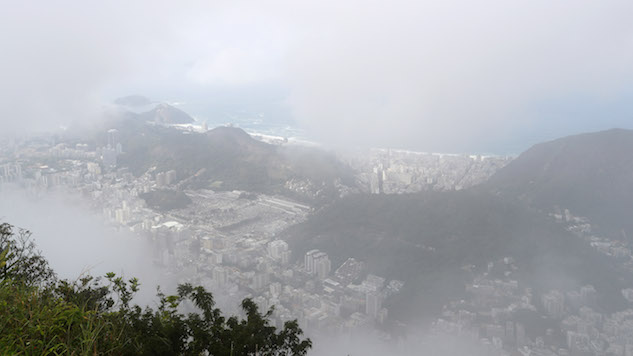On Visiting Rio de Janeiro Ahead of the Olympics
Photos courtesy Getty Images
Nightfall in Copacabana. Rain doesn’t seem to be falling as much as hovering in the air. Everything already damp by full darkness, the way you picture the tropics – with humidity and mosquitoes collecting on the inside walls and windows of the JW Marriott, making everyone in the lobby and hotel bar nervous. Or me, at least. I’m standing by the door, tracking my pending Uber ride, watching it do sort of Matrix-like maneuvers on the map, going backwards, sideways, the wait time bouncing between seven and thirteen minutes, even though it seems he’s right there. My skin is lacquered in 98% Deet Jungle Juice, my wrist brandishing a sort of Livestrong-esque rubber band reeking of repelling citronella, I have pre-treated my jeans with something called Permethrin, a chemical I was told by the salesman at REI to spray outside because it is strong enough to paralyze my cat. I’m still nervous, tapping my feet, fanning at phantom black specks that paranoia floats in front of my eyes.
And like that, seemingly by the time I’m buckled into the Peugeot, Ricardo has us parallel to traffic. He’s playing Frogger, moving left, then right, sort of steadily elbowing his way to the far lane before whipping a violent but smooth u-turn on Avenida Atlantica – one that I’ll become so familiar with on future trips to Santa Teresa. Or Botafogo. Or Flamengo. Or Centro. And we collectively let out a gut laugh, at his brazen maneuver, at the teeming traffic and how we got through, and we share a look. It’s a kind of conspiratorial glance, one that breaks our language barrier, an instant equalizer of the type that usually only flows from alcohol. Here we are, cohorts in a sea that is maybe not so crazy. And I loosen, and realize: despite the rain, despite my expectation, the continuous echoing clamor of months of headlines and NPR soundbites, despite the tricks of a worried mind, I actually have yet to see a single mosquito. Nor have I seen hints of communal anxiety. Not back at the hotel where patrons ate salmon and drank Bohemia and watched the Copa Cup. Where the concierge, Carmen, enthusiastically validated my live music selection for the night, with a wide smile, with a “yes, very local!” endorsement. And either way, by now I’m bound for caipirinhas and cerveja and samba and choro and the vestiges of welcoming, shambly Lapa.

A bit different than how Brazil had seemed from back home. My doctor, with furrowed brow, seemed concerned. “You think I shouldn’t go,” I asked, looking for validation to my own anxiety. “Why?” “You know, the Zika?” “It’s not that. It’s all the social unrest.” My barber informed me one of his clients had offered him free tickets to the Women’s Olympic Soccer Final. “He said he just couldn’t put his wife through the trip there.” “Why?” I responded, but he looked at me funny, in an eye-widened kind of “Duh!” My mom offered to go to a hospital Zika seminar, seemingly to let me know my chances of making it back alive. A native had sternly instructed: “Just never take your phone out of your pocket.” Co-workers continuously kept me updated: “You know they’re still talking about canceling the Olympics?” “Who is?” I would reply. Nobody seemed to know.
But I don’t care about the Olympics. Though fewer understand that, because all Rio is synonymous with currently—aside from Zika, corruption, crime, teeming favelas—is the sporting debacle. Yet here I am, weeks before the Games. And by trip’s end I will have eaten lunch in a favela, had dinner in a tree house, channeled Roger Moore-in-Moonraker by riding a gondola to the top of Sugarloaf. I’ll have been moved to tears by a bearded man in a sweatshirt, looking like everyone’s uncle, shuffling to a seat in a tiny samba jam session, pillow-voicing his Gilberto croon, breaking hearts, before ambling off alone toward the beach in a soft Copacabana fog, guitar slung over shoulder without a case. I’ll have fallen in love more times than is healthy for my marriage. And I will have seen, at most, three mosquitoes. Gotten zero bites. I will have relied on Uber and a preponderance of taxis—omnipresent, cheap, friendly—and a clean and easy subway. A dozen neighborhoods will have been negotiated, solo, in various levels of sobriety, all hours of the night, with zero knowledge of Portuguese beyond “Obrigado”, “bossa nova,” and “merhaba”—which is actually Turkish. And I will not feel threatened once. I will also have cursed Pau Gasol, that one golfer, that other golfer, those tennis players, quitting and blaming Zika, espousing uninformed medical anxieties and in the process denigrating an entire country (Do none of them realize the CDC has a rather helpful website?). And I will have scoffed at the state of journalism, all the fearmongering that nearly kept me home this summer.
Are there problems in Rio? Deep economic and sociopolitical calamities and dirty water? Terrible segregation and lousy public services? Yes. But as a foreigner visiting the city for the first time, all I can say is that things like the Orlando shooting and the threat of a Donald Trump presidency seemed very, very far away during my trip. I saw a city vastly different than the one presented in the media. In fact, it looked like everyone around me was talking about a completely different place…

Even if all you cover is the basics, Rio is almost impossibly, irresponsibly beautiful. The kind of place that if you’ve never been to any of Europe’s old grand cities, could be overwhelming, in a bad for your heart kind of way. And even if you have, the pulsing energy here might make a storied destination of the mind like, say, Rome, seem something akin to a museum piece.
You could hike, but the more pastel-fattened among us opt for an easy AC-ed van from Copacabana for the jaunt up Corcovado. The aerial views of Christ the Redeemer in pictures never look real, encourage instant airbrush suspicion. Yet 30 minutes through traffic and some switchbacks, and there it is, an even more impressive splay of city and mountain and ocean, with clouds framing the whole picture, the panoramic almost too much to digest, much too much for an iPhone. Beyond impressive even when clustered with hands-stretched, selfie-aiming tourists. Christo looks on from above, stoically. We have a moment, him and I, decide all is well. Well enough to grab a beverage at what has to be the most picturesque juice bar in the world – abacaxi (pineapple) because it’s fun to say, some pasteis, the requisite espresso. One should pick a clear day for the optimal view, though there’s certainly something to the sight of the statue, shrouded in mystical haze, that looks very much like the cover of an especially romantic Jobim album.
-

-

-

-

-

-

-

-

-

-

-

-

-

-

-

-

-

-

-

-

-

-

-

-

-

-

-

-

-

-

-

-

-

-

-

-

-

-

-

-











































